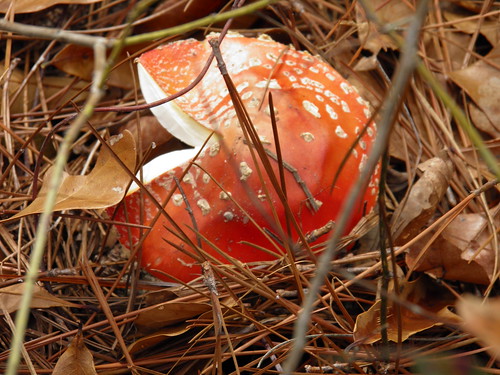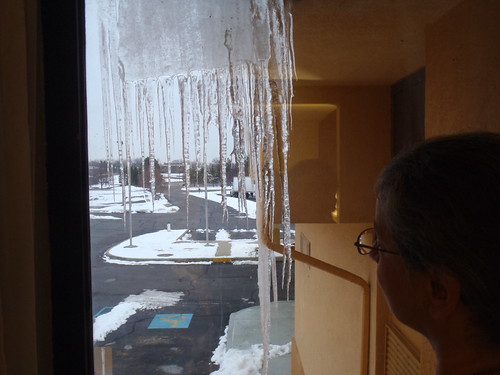Picture by John S. Quarterman of garlic planted by Gretchen Quarterman, Lowndes County, Georgia, 8 Jan 2011.
Collards
Something is living in there: Continue reading
Red spotted mushroom
Side view: Continue reading
Factory farming admits it needs collateral damage
 Tom Philpott writes in Grist that
Industrial Ag Once Again Demanding a Free Pass to Crap in Your Backyard:
Tom Philpott writes in Grist that
Industrial Ag Once Again Demanding a Free Pass to Crap in Your Backyard:
Industrial ag is admitting that it needs to trash its neighbors and the surrounding landscape to thrive. And it wants us to believe that there are no alternatives.His first example is Farm Bureau’s reaction to new EPA restraints on chicken farm factories around Chesapeake Bay, then he gets to Monsanto: Continue reading
Fewer pesticides for higher yields: if they can do it in west Africa…

West African farmers have succeeded in cutting the use of toxic pesticides, increasing yields and incomes and diversifying farming systems as a result of an international project promoting sustainable farming practices.Here’s the problem they are addressing: Continue readingAround 100 000 farmers in Benin, Burkina Faso, Mali and Senegal are participating in a community-driven training programme (West African Regional Integrated Production and Pest Management (IPPM) Programme) executed by FAO.
Icicles on a house
Picture of icicles from roof to ground taken in Lancaster, NY by John S. Quarterman. The homeowner removed them later with a hammer.
Icicles on a motel
French mulberry, or dwarf mulberry, becomes beautyberry
Further, William Bartram did mention it in his Travels of 1791, as
French mulberry.
Curiously, even though Google books does have Bartram’s book,
ngrams doesn’t seem to show French mulberry for that date,
but does show American mulberry.
Even more curious, William Bartram’s father, John Bartram,
corresponded with Linnaeus, the founder of modern
botanical terminology.
The currently most popular name is beautyberry, which turns out to be related to the scientific genus name, Callicarpa: Greek kalli means beautiful, and Karpos means fruit.
The plant has all sorts of uses: Continue reading
The Biotech Bully of St. Louis is having a Bad Year
All that and paraquat doesn’t work on mutant pigweed, either. The whole “no-till” fable is unravelling.Monsanto’s Roundup, the agro-toxic companion herbicide for millions of acres of GM soybeans, corn, cotton, alfalfa, canola, and sugar beets, is losing market share. Its overuse has spawned a new generation of superweeds that can only be killed with super-toxic herbicides such as 2,4, D and paraquat. Moreover, patented “Roundup Ready” crops require massive amounts of climate destabilizing nitrate fertilizer. Compounding Monsanto’s damage to the environment and climate, rampant Roundup use is literally killing the soil, destroying essential soil microorganisms, degrading the living soil’s ability to capture and sequester CO2, and spreading deadly plant diseases.
In just one year, Monsanto has moved from being Forbes’ “Company of the Year” to the Worst Stock of the Year. The Biotech Bully of St. Louis has become one of the most hated corporations on Earth.
The article mentions scientific studies about bad health effects of genetically modified foods, and goes on to warn of Monsanto maneuverings through the EPA and the Gates Foundation. Then he points to the European Union as leading the way: Continue reading
Callicarpa vs. Beautyberry
Anyway, comparing the common name beautyberry to the scientific name Callicarpa americana, it seems that the “common” name is much newer, at least in books.
Beautyberry is a piney woods bush that fruits as small violet berries that make tasty jars of jelly:


-jsq




